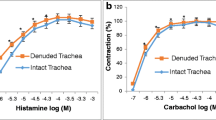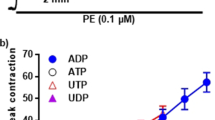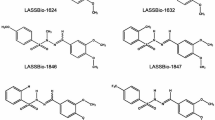Summary
The rank orders of potency of prostaglandin D2, prostaglandin F2α, 9α,11β-prostaglandin F2 and the stable thromboxane A2 mimetics U-46619 and ONO-11113 were determined in guinea-pig trachea and human bronchus in vitro. In both tissues the thromboxane mimetics were markedly more potent than the other prostanoids with EC50 values in the nanomolar range. The prostanoid antagonists BW-245C, EP-092 and GR-32191 attenuated the contractile responses to all of the prostanoid agonists and TXA2 mimetics tested in guinea-pig tracheal spirals, although agonist selectivity was seen. Contractile responses to methacholine in the guinea-pig trachea were unaffected by any of the antagonists employed. BW-245C antagonised the effects of all prostanoid agonists tested in human bronchial spirals, the pA2 values obtained were similar to those seen in the guinea-pig trachea when U-46619 and 9α,11β-PGF2 were employed as the agonists. However, significant differences were found between the two tissues when PGD2 and PGF2α. were tested against BW245C. EP-092 produced pA2 values against prostanoid agonists in the human bronchus similar to those seen in the guinea-pig trachea, as did GR-32191. It is concluded that whilst the contractile responses of guinea-pig and human airways smooth muscle to prostaglandin D2, and the other prostanoids are mediated predominantly via thromboxane (TP) receptors, it can be inferred that other receptor populations may contribute to the contractile response. The presence of these minor subpopulations may account for the agonist selectivity seen both within and between tissues from different species.
Similar content being viewed by others
References
Armstrong RA, Jones RL, Peesapati V, Will SG, Wilson NH (1985) Competitive antagonism at thromboxane receptors in human platelets. Br J Pharmacol 84:595–607
Bacon KB, Hoult JRS, Osborne DJ, Robinson C (1987) Metabolism of prostaglandin D2 to 9α,11β-PGF2 & subsequent transformation in rat, rabbit and guinea-pig. Br J Pharmacol 91:32P
Beasley CRW, Hovell CJ, Mani R, Robinson C, Holgate ST (1987a) The comparative vascular effects of histamine, prostaglandin D2 and its metabolite 9α,11β-PGF2 in human skin. Br J Clin Pharmacol 23:605-606P (Abstract)
Beasley CRW, Robinson C, Featherstone RL, Varley JG, Hardy CC, Church MK, Holgate ST (1987b) 9-α,11β-Prostaglandin F2, a novel metabolite of prostaglandin D2 is a potent contractile agonist of human and guinea pig airways. J Clin Invest 79:978–983
Coleman RA, Humphrey PPA, Kennedy I, Levy GP, Lumley P (1981) Comparison of the actions of U-46619, a prostaglandin H2 analogue with those of prostaglandin H2 and thromboxane A2 on some isolated smooth muscle preparations. Br J Pharmacol 73:773–778 P
Coleman RA, Kennedy I, Sheldrick RLG (1985) AH6809, a prostanoid EP1 receptor blocking drug. Br J Pharmacol 85:273
Coleman RA, Sheldrick RLG (1989) Prostanoid-induced contraction of human bronchial smooth muscle is mediated by TP-receptors. Br J Pharmacol 96:688–692
Farmer JB, Farrar DG, Wilson J (1974) Antagonism of tone and prostaglandin-mediated responses in a tracheal preparation by indomethacin and SC-19220. Br J Pharmacol 52:559–565
Flower RJ, Harvey EA, Kingston WP (1976) Inflammatory effects of prostaglandin D2 in rat and human skin. Br J Pharmacol 56:229–233
Fujioka M, Nagao T, Kuriyama H (1986) Actions of the novel thromboxane A2 antagonists ONO-1270 and ONO-3708 on smooth muscle cells of the guinea-pig basilar artery. Naunyn-Schmiedeberg's Arch Pharmacol 334:468–474
Gardiner PJ (1986) Characterisation of prostanoid relaxant/inhibitory receptors using a highly selective agonist, TR4979. Br J Pharmacol 87:45–56
Gardiner PJ, Collier HOJ (1980) Specific receptors for prostaglandins in the airways. Prostaglandins 19:819–841
Gardiner PJ, Jones RL, McKenniff M, Norman P, Rodger I (1987) Prostanoid contractile receptors on guinea-pig and human air-ways. Br J Pharmacol 91:363P
Giles H, Leff P, Bolofo ML, Kelly MG, Robertson AD (1989) The classification of DP-receptors in platelets and vasculature using BW-868C, a novel, selective and potent competitive antagonist. Br J Pharmacol 96:291–300
Godard P, Chaintreuil J, Damon M, Coupe M, Flandre O, Crastes De Paulet A, Michel FB (1982) Functional assessment of alveolar macrophages: comparison of cells from asthmatics and normal subjects. J Allergy Clin Immunol 70:88–93
Goetzl EJ, Weller PF, Valone FH (1976) Biochemical and functional bases of the regulatory protective roles of the human eosinophil. Advances Inflammation Res 1:157–167
Gorman RR, Shebuski RJ, Aiken JW, Bundy GL (1981) Analysis of the biological activity of azo-prostanoids in human platelets. Fed Proc 40:1997–2000
Hamid-Bloomfield S, Whittle BJR (1986) Prostaglandin D2 interacts at thromboxane receptor sites on guinea-pig platelets. Br J Pharmacol 88:931–936
Hardy CC, Holgate ST, Robinson C (1986) Evidence against the formation of 13,14-dihydro-15-keto-prostaglandin F2α following inhalation of prostaglandin D2 in man. Br J Pharmacol 87:563–568
Holgate ST, Burns GB, Robinson C, Church MK (1984) Anaphylactic and calcium dependent generation of prostaglandin D2 (PGD2), thromboxane B2 and other cyclooxygenase products of arachidonic acid by dispersed human lung cells and relationship to histamine release. J Immunol 133:2138–2144
Jones RL, Peesapati V, Wilson NH (1982) Antagonism of thromboxane-sensitive systems of the rabbit aorta, dog saphenous vein and guinea-pig trachea. Br J Pharmacol 76:423–438
Katsura M, Miyamoto T, Hamanaka N, Kondo K, Terada T, Ohgaki Y, Kawasaka A, Tsuboshima M (1983) In vitro and in vivo effects of new powerful thromboxane antagonists (3-alkylaminopinane derivatives). Adv Prostaglandin Thromboxane Leukotriene Res 11:351–357
Kawahara Y, Yamanishi J, Furuta Y, Kaibuchi K, Takai Y, Fukuzaki H (1983) Elevation of cytoplasmic free calcium concentration by a stable thromboxane A2 analogue in human platelets. Biochem Biophys Res Commun 117:663–669
Kenakin TP (1984) The relative contributions of affinity and efficacy to agonist activity: organ selectivity of noradrenaline and oxymetazoline with reference to the classification of drug receptors. Br J Pharmacol 81:131–134
Kennedy I, Coleman RA, Humphrey PPA, Levy GP, Lumley P (1982) Studies on the characterization of prostanoid receptors: a proposed classification. Prostaglandins 24:667–689
Leighton MJ (1982) Quantitative assessment of the pre- and post-synaptic alpha adrenoceptor agonist potency of amitriptyline. J Pharmacol Exp Ther 220:299–304
Lewis RA, Soler NA, Diamond PT, Austen KF, Oates JA, Roberts LJ (1982) Prostaglandin D2 generation after activation of rat and human mast cells with anti-IgE. J Immunol 129:1627–1631
Liston TE, Roberts LJ (1985a) Transformation of prostaglandin D2 to 9α,11β-(15S)-trihydroxy-prosta-(5Z,13E)-dien-1-oic acid (9α,11 β-prostaglandin F2): a unique biologically active prostaglandin produced enzymatically in vivo in humans. Proc Natl Acad Sci USA 82:6030–6034
Liston TE, Roberts LJ (1985b) Metabolic fate of radiolabelled prostaglandin D2 in a normal human male volunteer. J Biol Chem 260:13172–13180
Lumley P, Humphrey PPA, White BP (1988) GR-32191, a novel thromboxane receptor blocking drug; effects upon platelets and vascular and airways smooth muscle. Br J Pharmacol 93:43P
McKenniff M, Gardiner PJ, Norman P, Rodger IW (1987) Is there a novel contractile prostanoid receptor in human large airways. Br J Pharmacol 93:56P
Morley J (1983) Mediators and cyclic nucleotides in asthma. In: Clark TJH, Godfrey S (eds) Asthma. Chapman and Hall, London, pp 285–300
Narumiya S, Toda N (1985) Different responsiveness of prostaglandin D2-sensitive systems to prostaglandin D2 and its analogues. Br J Pharmacol 85:367–375
Richards IM, Oostveen JA, Griffin RL, Bunting S (1987) Pulmonary pharmacology of synthetic thromboxane A2. Adv Prostaglandin Thromboxane Leukotriene Res 17B:1067–1072
Vane JR (1971) Inhibition of prostaglandin synthesis as a mechanism of action for aspirin-like drugs. Nature, New Biol 231:232–235
Author information
Authors and Affiliations
Additional information
Send offprint requests to: R. L. Featherstone at the above address
Rights and permissions
About this article
Cite this article
Featherstone, R., Robinson, C., Holgate, S. et al. Evidence for thromboxane receptor mediated contraction of guinea-pig and human airways in vitro by prostaglandin (PG) D2, 9α,11β-PGF2 and PGF2α . Naunyn-Schmiedeberg's Arch Pharmacol 341, 439–443 (1990). https://doi.org/10.1007/BF00176337
Received:
Accepted:
Issue Date:
DOI: https://doi.org/10.1007/BF00176337




